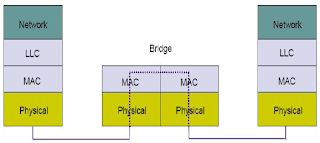Interconnection by bridge
• The no frills bridge : simply
transmit all traffic from one LAN segment onto all
the other segments
– Advantages: two stations can be
transmitting at the same time. Bridge
will buffer a packet until it can
transmit on a LAN
– Disadvantages: total bandwidth
still that can be safely utilized is still the
minimum bandwidth of each LAN segment
• Keeping a database of all
stations on each LAN segment
– Manually enter addresses in
such a database
– Partition addresses into ranges
on each LAN
• Eg. LAN 1 has 1-50, LAN 2 has
51-100, LAN 3 has 101-150
– Have the MAC address be
hierarchically divided into a LAN address and a
station address (like the IP
address)
– None of these solutions are
really used
• Better solution: the
transparent learning bridge
– Learn on which segment a
station resides
– Transmit a packet only onto the
correct segment
• bridges learn which
hosts can be reached through which interfaces: maintain
filtering tables
– when frame received, bridge “learns”
location of sender: incoming LAN
segment
– records sender location in
filtering table
• filtering table entry:
– (Node LAN Address, Bridge
Interface, Time Stamp)
– stale entries in Filtering
Table dropped (TTL can be 60 minutes)
• filtering procedure:
– if destination is on LAN
on which frame was received
• then drop the frame
• else { lookup filtering
table
• if entry found for
destination
• then forward the frame
on interface indicated;
• else flood; /*
forward on all but the interface on
which the frame
arrived*/
• }







0 comments